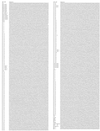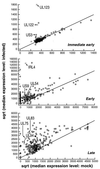DNA microarrays of the complex human cytomegalovirus genome: profiling kinetic class with drug sensitivity of viral gene expression
- PMID: 10364327
- PMCID: PMC112636
- DOI: 10.1128/JVI.73.7.5757-5766.1999
DNA microarrays of the complex human cytomegalovirus genome: profiling kinetic class with drug sensitivity of viral gene expression
Abstract
We describe, for the first time, the generation of a viral DNA chip for simultaneous expression measurements of nearly all known open reading frames (ORFs) in the largest member of the herpesvirus family, human cytomegalovirus (HCMV). In this study, an HCMV chip was fabricated and used to characterize the temporal class of viral gene expression. The viral chip is composed of microarrays of viral DNA prepared by robotic deposition of oligonucleotides on glass for ORFs in the HCMV genome. Viral gene expression was monitored by hybridization to the oligonucleotide microarrays with fluorescently labelled cDNAs prepared from mock-infected or infected human foreskin fibroblast cells. By using cycloheximide and ganciclovir to block de novo viral protein synthesis and viral DNA replication, respectively, the kinetic classes of array elements were classified. The expression profiles of known ORFs and many previously uncharacterized ORFs provided a temporal map of immediate-early (alpha), early (beta), early-late (gamma1), and late (gamma2) genes in the entire genome of HCMV. Sequence compositional analysis of the 5' noncoding DNA sequences of the temporal classes, performed by using algorithms that automatically search for defined and recurring motifs in unaligned sequences, indicated the presence of potential regulatory motifs for beta, gamma1, and gamma2 genes. In summary, these fabricated microarrays of viral DNA allow rapid and parallel analysis of gene expression at the whole viral genome level. The viral chip approach coupled with global biochemical and genetic strategies should greatly speed the functional analysis of established as well as newly discovered large viral genomes.
Figures




References
-
- Barnard D L, Huffman J H, Sidwell R W, Reist E J. Selective inhibition of cytomegaloviruses by 9-(3′-ethylphosphono-1′-hydorxymethyl-1′-propyloxy-methyl) guanine. Antiviral Res. 1993;22:77–89. - PubMed
-
- Chee M S, Bankier A T, Beck S, Bohni R, Brown C M, Cerny R, Horsnell T, Hutchison III C A, Kouzarides T, Martignetti J A, Preddie E, Satchwell S C, Tomlinson P, Weston K M, Barrell B G. Analysis of the protein-coding content of the sequence of human cytomegalovirus strain AD169. Curr Top Microbiol Immunol. 1990;154:125–170. - PubMed
Publication types
MeSH terms
Substances
Grants and funding
LinkOut - more resources
Full Text Sources
Other Literature Sources

